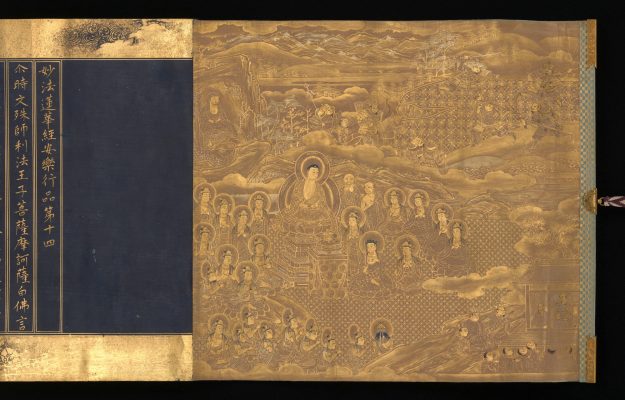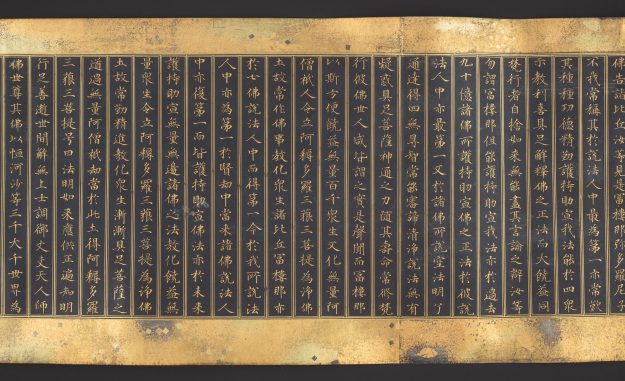Known as the “King of Sutras,” the Lotus Sutra is one of the most influential texts in East Asian Buddhism. As the scriptural basis for the Tendai tradition, the dominant form of Buddhism in medieval Japan, it strongly influenced the newly developing schools of the time, including Nichiren, Pure Land, and Zen Buddhism. Centuries later, the teachings in the Lotus are likewise foundational to those schools’ counterparts in the West, something contemporary practitioners are often unaware of.
First recorded in first-century BCE India, the Lotus continued to evolve over the next three centuries. It came to be understood by its adherents as the Buddha’s final teaching, and, as the “one vehicle” (Skt., ekayana), it claimed to include, and supersede, all earlier teachings. The Lotus’s core tenets, such as the notion that enlightenment is available to all and its emphasis on earlier teachings as skillful means, came to characterize Mahayana Buddhism in East Asia.
With its extravagant and cryptic narratives, the Lotus is a text many readers may find daunting, but that needn’t be the case any longer. In Two Buddhas Seated Side by Side: A Guide to the Lotus Sutra, scholars Jacqueline Stone and Donald Lopez Jr. make this sacred text accessible with a chapter-by-chapter guide, covering the scripture’s origins, its evolution, and its defining influence on later schools.
Named after an iconic scene from the sutra in which two buddhas—a radical statement on the plurality of buddhahood—sit together within a jeweled stupa, the book traces the Lotus Sutra’s many iterations, with special emphasis on one of its most famous interpreters and proponents, the Japanese Buddhist priest Nichiren (1222–1282 BCE).
Lopez and Stone expand their exegesis to a broader discussion of how religions evolve to accommodate their adherents’ contemporary realities. I sat down to speak with Lopez and Stone about Two Buddhas in a podcast interview last fall.
Lopez, the Arthur E. Link Distinguished University Professor of Buddhist and Tibetan Studies at the University of Michigan, and Stone, who recently retired from her position as Professor of Japanese Religions at Princeton University, are together two of the foremost scholars of Buddhist studies.
—James Shaheen
***
Why should, say, a Zen practitioner read the Lotus Sutra?
Jacqueline Stone: My own bias is that practice is only going to be enhanced by doctrinal and historical understanding. But apart from that, the Lotus Sutra has been one of the most influential Buddhist texts in East Asia.
How so?
The Tendai (Chinese, Tiantai) tradition [widely revered in China, Korea, and Japan], through its embrace of the Lotus, shaped Pure Land, Zen, and Nichiren approaches to practice. The Lotus Sutra’s claims that all teachings are encompassed in one vehicle, that the truth realized by the Buddha is inherent in all things, and that buddhahood is open to all have influenced Buddhist thinking across denominations.
In the broader East Asian religious culture, the metaphors and parables in the Lotus Sutra—such as the three carts and the burning house, the gem and the robe, and the story of the great physician—are important to Buddhist art and literature. These images are represented again and again, reworked into tales, poetry, and drama. And the two buddhas seated side by side inside a stupa floating in the air—from which we took the title of our book—appear often in East Asian Buddhist painting and sculpture. I think that whatever one’s particular persuasion—whether a Zen practitioner, a Pure Land devotee, or a follower of Nichiren—they will learn more about their own tradition from exposure to this text.
How are the parables used to teach in the text?
Donald Lopez: The Lotus is most famous in the West for its teaching of the one vehicle, which is portrayed in several of the sutra’s parables, most notably in the parable of the burning house.
The children of a wealthy father are playing in a large house when a fire breaks out. The children are so engrossed in their games that they pay no attention to their father’s pleas to get out. It’s a bad fire. There isn’t time for him to go in and take them out one by one. He tells them, if you come out, I have some carts for you. There’s a cart that’s drawn by a deer, a cart that’s drawn by a sheep, and a cart that’s drawn by an ox. That gets the children’s attention and they all come out, but they find just one cart drawn by a large white ox. Nonetheless, they’re overjoyed to have this beautifully adorned vehicle, much grander than any their father had originally promised.
The Lotus Sutra has been one of the most influential Buddhist texts in East Asia.
And so the Buddha says: I’m the father, all sentient beings are my children, and in order to get them to flee the conflagration of samsara, the realm of rebirth, I tell them that there are three vehicles to salvation. One is the vehicle of the shravaka, or the disciple; one is the vehicle of the pratyekabuddha, or the solitary enlightened one; and one is the vehicle of the bodhisattva. But in fact, there’s just one: the one great vehicle, the buddhayana, the Buddha vehicle; or ekayana, the single vehicle that takes all beings to buddhahood.
This is the most famous parable among many in the Lotus Sutra because it teaches that there really is just one vehicle, and that everyone is going to become a bodhisattva and then a buddha instead of an arhat, the goal of what scholars call “mainstream Buddhism,” represented today by the Theravada.

The Lotus Sutra doesn’t deny that the Buddha taught the four noble truths, the eightfold path, and so on. All those things are accepted. The previous tradition is not rejected at all; it’s simply reinterpreted.
After recounting the parable of the burning house, the Buddha asks his disciple Shariputra a question: Did the father lie when he told the children that there were three vehicles? Was that a falsehood? And Shariputra says: No, because he wanted to save the lives of his beloved children. He used this expedient device to get them out.
Can you say more about that term, “expedient device”?
JS: “Expedient device” or “skillful means”—there are multiple translations. This is the idea that the Buddha has the wisdom to assess the capacity of the people he’s addressing and express himself in a way that they can understand. And so in a way we could say that all the Buddha’s teachings are expedient means because they were addressed to specific people at specific moments and they worked for those people at that time. The Lotus Sutra makes this claim. But underneath all of those teachings, it says, there’s a unified aim: Ultimately they are leading people toward a single goal—that of buddhahood itself.
So there’s a polemical strategy here, right?
JS: Definitely. This is Mahayana Buddhism, which was positioning itself against the Buddhist mainstream. And so we have here a tremendous re-visioning of the entire received tradition.
What do you mean when you use the term “mainstream” Buddhism?
DL: What we are trying to name is the tradition of Buddhism before the Mahayana began, which was probably several centuries after the Buddha’s death. We now know with some certainty that the Mahayana, despite its great fame in East Asia, remained a minority tradition throughout its long history in India. Everything else we just call the “mainstream.” These mainstream schools, of which there were many, tended to reject the Mahayana sutras, saying that they were not the word of the Buddha. They maintained the nirvana of the arhat as the ideal. This is not to say that they did not speak of the bodhisattva. Rather, they saw the bodhisattva as the rare figure who foregoes the path of the arhat to follow the longer bodhisattva path. The Lotus says that the nirvana of the arhat does not ultimately exist and that all beings can become bodhisattvas and thus buddhas.
JS: The Lotus Sutra extols the bodhisattva path as a path that everyone should follow in order to become a buddha. The compilers—Mahayana practitioners—faced the very difficult task of explaining why the Buddha himself didn’t teach that, then, instead of offering the path of the arhat that leads to personal nirvana, the extinction of desire, and the stopping of the wheel of rebirth.
The Lotus Sutra’s answer, again, is that the Buddha preached to different people according to their capacity, but underlying those diverse teachings was his final intention: to lead everyone to the single goal of buddhahood.
Why don’t we take that a little bit further: What does the Lotus Sutra do to legitimize itself or to give itself authority?
JS: The Lotus positions itself as the Buddha’s supreme teaching. And it does that in many ways. First of all, it’s presented as the Buddha’s final teaching. He’s about to enter nirvana, and so he preaches the sutra.
In the opening chapter, there’s a scene where the Buddha emerges from meditation and flowers fall from the sky and the earth shakes. The bodhisattva Maitreya, who is supposed to be the next buddha and therefore should be extremely wise, doesn’t know what’s going on, so he asks the more experienced bodhisattva Manjushri what’s happening. Manjushri recalls a scene from unfathomable kalpas [eons] ago, in the age of another buddha. Shortly before that buddha entered nirvana, the same signs appeared, and immediately afterward he preached the Sutra of the Lotus Blossom of the Wonderful Dharma.That’s what Shakyamuni is now going to do.
So the Lotus positions itself as both the final teaching and one that’s older than anything recorded in the Buddhist tradition. And most interestingly, it repeatedly refers to itself in the course of the text. It’s an actor in its own script, if you will.

So how was this idea—that the Lotus was his final teaching—received?
DL: There were many in India who rejected the claim that the Mahayana sutras were the word of the Buddha. Great scholars like Nagarjuna, Bhaviveka, and Shantideva wrote defenses of the Mahayana over the course of centuries, so we know that the criticism never went away.
But the Lotus Sutra also legitimizes itself in other ways. Of course, the mainstream criticism would be: If the Buddha taught this, why do we have no record of it being taught? If the Buddha taught this, why is it not in the Tripitika, the previously accepted canon?
There are ways of legitimizing that don’t rest on the historical question of was this or was this not preached by the Buddha.
As the Buddha is about to preach the Lotus Sutra, he says, “I’m now going to begin teaching. I’m going to teach you something I’ve never taught before. I’m going to reveal the true teaching.” Five thousand monks and nuns get up and walk out. The Buddha doesn’t stop them.
The sutra is therefore saying that five thousand monks and nuns didn’t hear him preach it and therefore they don’t know about it. For the sutra’s champions, this passage provided a reason why so many claimed that the Lotus was not taught by the Buddha; they were among those who walked out when he began to teach it.
That’s pretty clever. In your new book, Two Buddhas Seated Side by Side, we’re looking at two different things: the sutra as it has come down to us from the time of its composition, some three or four hundred years after the Buddha, and then the centuries of interpretation that followed. So if I read the Lotus Sutra, I’m not going to pick up what Nichiren [1222–1282 CE] extrapolated from it hundreds of years after its composition.
JS: Right. That was precisely one of the reasons for doing the book. On the one hand, it is a chapter-by- chapter guide to the Lotus Sutra—a text that speaks in mythic imagery rather than discursively, so it’s very hard to read cold, without background explanation. At the same time, we conceived of this as a study in religious interpretation—how people reimagine or refigure their traditions in response to changing circumstances. Part of the book, then, looks at the way that Nichiren, roughly a thousand years later at the extreme opposite end of Asia, took the Lotus Sutra and the long tradition of its interpretation and reworked them to fit the needs of his time. We conceived of the book as an introduction to this problem of how religions stay alive and readjust to changing circumstances.
In the modern era, we face exposure to all sorts of different beliefs, and there is no really good reason for deciding that one’s own is superior to anyone else’s. But we still have to find value in the foundational texts. As you discussed, in Pali Buddhism, or Theravada, that meaning seems to rest on the claim that the teachings were the words of the Buddha. Yet like Nichiren, we have to come back to some texts and interpret them in ways that are relevant to our time. Is that right?
And further, all religious texts try to make a claim to authenticity, and they have various ways of doing it. But if we acknowledge the role that interpretation has played historically in the teaching of not only the Lotus but really all Buddhists texts, and that we’re not looking at them as the actual words of the Buddha, how do we then read them in a fruitful way? How do I understand its historical context and at the same time find great spiritual value in it?
JS: This is not a new issue. I think, for example, about Japan in the early 20th century when Buddhist leaders there had their first encounters with European Buddhist Studies. At the time, the Pali canon was thought by Western researchers to be closest to the direct preaching of the historical Buddha. We now know that the matter is much more complex, but at that time, the Mahayana was often considered a later, degenerate form. Japanese Buddhist scholars, many of whom were also Buddhist priests, had to find a way to reclaim the Mahayana, their own tradition, and they did this by saying, OK, maybe the Mahayana teachings weren’t the direct words of the historical person, Shakyamuni. But if we take seriously the idea that all people have buddhanature and access to buddha wisdom, there is no reason why new forms of that message can’t appear in order to inspire people and answer the needs of the present. It’s an argument based on what’s deep and compelling philosophically rather than on historical origins. There are ways of legitimizing that don’t rest on the historical question of was this or was this not preached by the Buddha.
What I tell my students is that any practitioner-believer, someone involved in a tradition—whether consciously or not—is involved in a process of “hermeneutical triangulation,” as we might call it. They are continually having to negotiate between the received tradition and the social, political, and historical circumstances in which they live. At any moment, some parts of the received tradition are going to speak more powerfully, more cogently, than others. Other elements that perhaps were important in the past may now become marginalized; still others may be interpreted in novel ways. Practitioners are continually involved in this process. The more conscious one is of engaging in it, the more effective new adaptations of tradition are likely to be.
DL: Before we began the book and perhaps even more strongly after we finished it, Jackie and I both felt that one’s appreciation of the Lotus Sutra is enhanced by understanding the circumstances of its composition. Rather than thinking of it as a transcendent truth that an unknown buddha taught billions of years ago and that all the buddhas teach over and over again through time, we might think of it instead as the product of a creative yet beleaguered community of Buddhist monks and nuns in India who knew doctrine very well, monks and nuns who were visionaries able to compose a text that from every perspective is a religious and literary masterpiece. We see the Lotus as a text that is able to take the tradition and reinterpret it for its devotees’ own time in a way that welcomes all sentient beings onto the great vehicle to buddhahood, a text that has passages whose beauty will make you weep. Speaking for myself, that in many ways is more inspiring than to think of it simply as the words of a distant transcendent being.
Thank you for subscribing to Tricycle! As a nonprofit, we depend on readers like you to keep Buddhist teachings and practices widely available.
